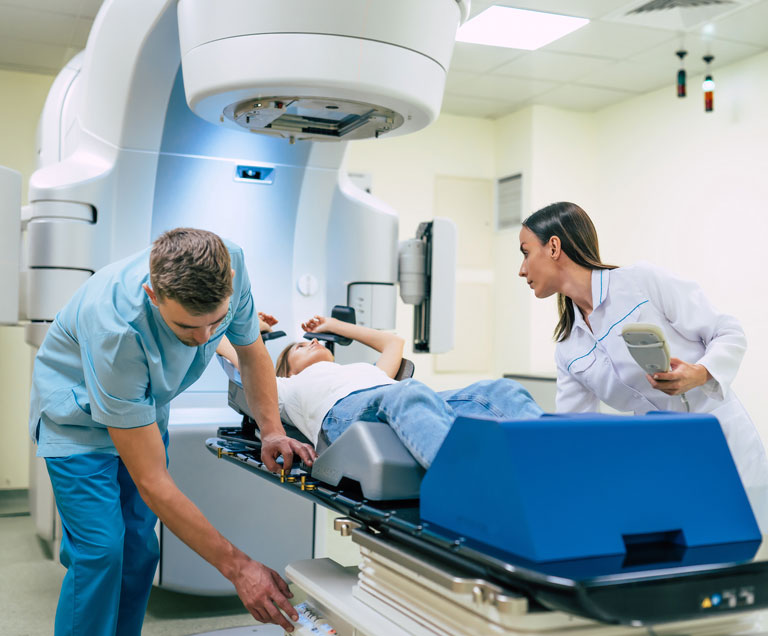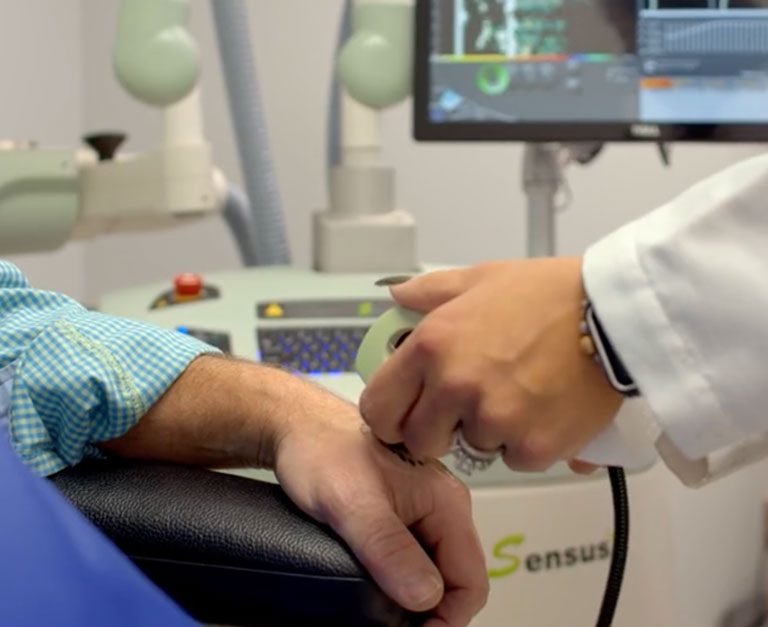What Is Image-Guided SRT? / Radiation Treatment
Image-Guided SRT Is Not the Same as Other Radiation Treatments
Radiation is used in many ways to treat many types of cancer. Radiation therapy kills cancer cells or slows their growth by damaging their DNA. Cancer cells whose DNA is damaged beyond repair stop dividing and die. They are then removed by the body.
When choosing the right treatment for your skin cancer, it is important to learn about your options: not all radiation treatments are the same. You should know that Image-Guided Superficial Radiation Therapy (Image-Guided SRT) is different not only from radiation used to treat other types of cancer, but also from other skin cancer radiation options.
How is Image-Guided SRT different from radiation treatments for other types of cancer?
When people think of radiation treatment, they most often think of the 2 main forms of radiation used to treat cancers like breast, prostate, or lymphoma. These types of radiation are very different from Image-Guided SRT.

*Not an actual patient.
External beam radiation therapy
- A machine, which can be large and noisy, sends radiation to the part of the body where the cancer is
- Given in a hospital or radiation center
- Uses high energy to deliver high doses of radiation
- Designed to treat cancers inside the body, not on the skin
- Damages healthy cells around the cancer, causing side effects, which vary depending on many factors like the type, size, and stage of the cancer and how much radiation is given

*Not an actual patient.
Internal radiation therapy
- The source of the radiation (solid or liquid) is put inside your body
- Solid sources of radiation can be seeds, ribbons, or capsules that give off radiation in the area where they are implanted
- Liquid sources of radiation travel through the blood to the cancer cells throughout your body
- Given or implanted in a hospital or radiation center
- Can cause people to give off radiation for a while after treatment
- Damages healthy cells around the cancer, causing side effects, which vary depending on many factors like the type, size, and stage of the cancer and how much radiation is given

Image-Guided Superficial Radiation Therapy (Image-Guided SRT)
- Uses low-energy X-rays, like the X-rays used at a dentist’s office, to deliver doses to skin cancer
- Goes only as deep as the skin
- Uses ultrasound images to measure the size and depth of the cancer, determine the lowest dose of X-rays needed, and track how the cancer responds to treatment
- Is given by a Radiation Therapist who works together with a dermatologist to deliver treatment right in the dermatologist’s office
- Does not cause the person to give off radiation after treatment
- Has little to no effect on healthy cells around the cancer
- Has mild to moderate side effects that go away within weeks of finishing treatment
Image-Guided SRT is better than other skin cancer radiation treatments
There are different types of radiation treatments for skin cancer. Understanding the differences between each treatment can help you talk with your dermatologist about what you want from and during treatment.
IG-SRT
Image-Guided Superficial Radiation Therapy (Image-Guided SRT)
- Uses low-energy X-rays, like the X-rays used at a dentist’s office, to deliver doses to skin cancer
- Cures over 99% of basal or squamous cell skin cancers
- Goes only as deep as the skin and has little to no effect on the area around the cancer
- Given right in a dermatologist’s office by a Radiation Therapist who works together with the dermatologist
- First and only radiation treatment for skin cancer that uses ultrasound images to measure the size and depth of the skin cancer to know exactly how much X-ray energy to use, track how the cancer is responding, and know the cancer is gone
- Has mild to moderate side effects
- Over 99% patient satisfaction with the outcome and treatment experience
SRT
Superficial Radiation Therapy (SRT)
- Uses low-energy X-rays to the surface of the skin using a special machine
- Cures the majority of basal and squamous cell skin cancers
- Dermatologist estimates the size and shape of the skin cancer area
- Does not use imaging, so the dermatologist cannot measure the size and depth of the cancer and cannot see how the cancer is responding to treatment
- Has mild to moderate side effects
- Most patients approve of the outcome and treatment experience
EBRT
Electron-Beam Radiotherapy (EBRT)
- Delivers electron beam therapy to the skin through a large machine at a radiation treatment center or hospital
- Uses higher energy dosing than SRT that is aimed at the entire area of the body where the cancer is located
- Has lower overall cure rates for nonmelanoma skin cancers and is often used on advanced, deeper skin cancers that need a deep, below-the-skin treatment
- Has mild to moderate side effects
- Most patients approve of the outcome and treatment experience
EBX
Electronic Brachytherapy (EBX)
- Delivers X-rays with very high doses of radiation using a special machine
- Often limited in its use to smaller skin cancer areas
- Has very little scientific evidence for cure rates of nonmelanoma skin cancers
- Has mild to moderate side effects
- Less than half of patients approve of the outcome and treatment experience
Answers to common questions about skin cancer radiation treatment with Image-Guided SRT
There can be confusion when it comes to getting radiation treatment for skin cancer. Here are answers to common questions about Image-Guided SRT to address the myths about this type of skin cancer radiation treatment.
Image-Guided SRT uses low-energy radiation, like the X-rays given in your dentist’s office. This radiation goes only as deep as your skin and does not affect other parts of your body. There is not one documented case of a secondary cancer occurring from Image-Guided SRT. Ultraviolet (UV) radiation from the sun’s rays and tanning beds is the leading cause of skin cancer. The radiation levels and delivery used in Image-Guided SRT are much different than that of traditional radiation and the safety and effectiveness are supported by years of clinical studies.
When choosing the right skin cancer treatment for you, talk with your dermatologist and radiation therapist about any concerns you may have.
As with any medical procedure, there are some potential side effects of Image-Guided SRT.
- The most common side effects are usually mild to moderate irritation, redness, thinning, or breakdown of the skin that was treated, which may increase the risk for a skin infection.
- These side effects can be cared for by your doctor and usually go away within 2 to 6 weeks after treatment ends.
- Some people may notice that the skin that was treated becomes darker or lighter. Hair loss may also happen to the skin that was treated.
- Rare side effects include a skin ulcer that does not heal and another cancer forming in the same area 20 to 40 years after treatment
Talk with your dermatologist about the possible side effects of Image-Guided SRT and get answers to any questions you may have.
Side effects of external and internal radiation used to treat other types of skin cancer can be severe for some people. Side effects depend on the type of radiation given, the dose, the type of cancer and area being treated, and the person’s health history.
No. Some types of radiation used to treat other types of cancer, though, can cause the person to be radioactive after treatment. That means the person will give off radiation for a while after treatment and may need to limit activities or contact with others.
That is not a concern for people who get Image-Guided SRT. Image-Guided SRT uses low-energy X-rays to deliver doses of radiation to the surface of the skin. The radiation stays in the skin and continues to kill the cancer cells between visits, but the person is not radioactive. It is the same level of X-rays used to X-ray teeth at a dentist office. A radiation therapist can show you the Image-Guided SRT machine before you start treatment and answer any questions you may have.
Yes, but not the radiation used for skin cancer treatment.
Ultraviolet (UV) radiation from the sun’s rays and tanning beds is the leading cause of skin cancer. The best way to prevent skin cancer is to use a broad-spectrum sunscreen with a skin protection factor (SPF) of 30 or higher and to avoid the use of tanning beds and sun lamps.
It is important to remember that up to half of all people who have had one skin cancer will have another within five years. Sometimes, that new skin cancer is mistaken for the old skin cancer coming back. Some people think that the radiation treatment caused a new skin cancer, when it is likely from the sun’s damaging rays. Getting full-body skin checks and having open, honest conversations with your dermatologist are important for those at risk for skin cancer.
Download this guide to learn more about the differences between skin cancer radiation treatments.
Everyone Deserves a Surgery-Free Treatment Option
Participate in change. Do not let radiation oncologists limit your treatment options to protect their income. Sign a FREE petition to tell Medicare and health insurers that you expect them to CONTINUE COVERING an FDA-cleared, less invasive treatment option.